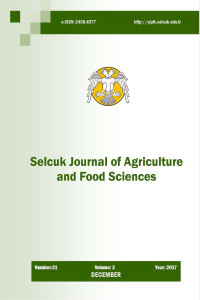Abstract
One of the important reasons for the low yield in the Turkey viticulture sector is that the vineyard plantations are established from material that has not been selected for clonally. ‘Ekşi Kara’ (Vitis vinifera L.) grape variety clonal selection study is being carried out by the Department of Horticulture of Selcuk University Faculty of Agriculture, which is widely grown in the vineyards of the Central Southern Anatolian Region of the Middle Taurus Mountains. It is suitable for multi-purpose usage, Vitis vinifera L. grape variety. In the clonal selection project Konya (Hadim, Bozkır and Güneysınır) and Karaman provinces initiated in 2010, 220 clone candidates (CC) were identified, taking into consideration the plant health, yield and development status in 15 areas that represent the variety well. This study was carried out in order to determine the difference in productivity potential between CC and the bud samples taken from their natural environment in producer conditions. Fertility (number of inflorescence per shoot) is a very important feature in grapevine improvement taht is affected by internal and external factors as well as the genetic capacity of the variety. Yield potential was investigated during the dormant periods of buds. 1st to 10th buds were sprout in greenhouse and inflorescences reached the visible level, fruitfulness was identified by counting the inflorescences numbers per shoot. The average yield of 2200 buds collected from 220 CC in 15 vineyards was 0.77. When all the CC were evaluated together, an overall relative decrease in the number of inflorescence per shoot was determined, depending on the position of the bud along the shoot. The average inflorescence numbers from basal to upward buds were 0.97 ± 0.35, 0.88 ± 0.35, 0.92 ± 0.35, 0.86 ± 0.36, 0.74 ± 0.35, 0.74 ± 0.34, 0.75 ± 0.33, 0.69 ± 0.35, 0.64 ± 0.32 and 0.53 ± 0.34 respectively. There were no more than 2 inflorescences in the CC while 0 to 2 inflorescences were determined at different positions. It is thought that when CC are not able to accurately reflect the genetic potential of the variety, the yield potency in shoots taken from the natural environment may lead to misleading results in the selection of clone candidates.
Details
| Primary Language | English |
|---|---|
| Subjects | Horticultural Production |
| Journal Section | Research Article |
| Authors | |
| Publication Date | December 29, 2017 |
| Submission Date | July 17, 2017 |
| Published in Issue | Year 2017 Volume: 31 Issue: 3 |
Cite
Selcuk Agricultural and Food Sciences is licensed under a Creative Commons Attribution-NonCommercial 4.0 International License (CC BY NC).


